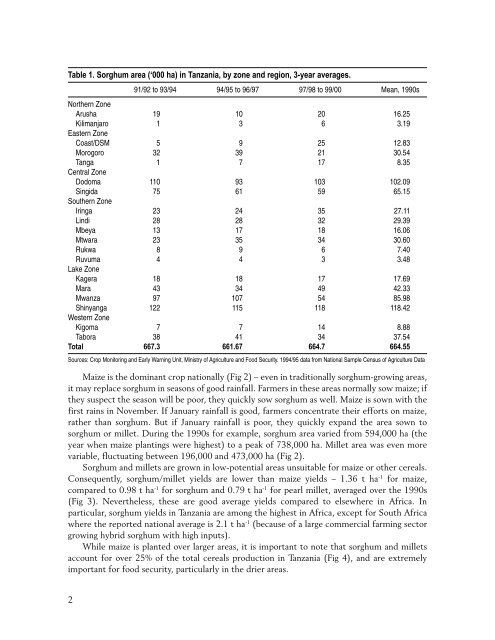Adoption of Improved Sorghum and Pearl Millet ... - Icrisat
Adoption of Improved Sorghum and Pearl Millet ... - Icrisat
Adoption of Improved Sorghum and Pearl Millet ... - Icrisat
Create successful ePaper yourself
Turn your PDF publications into a flip-book with our unique Google optimized e-Paper software.
Table 1. <strong>Sorghum</strong> area (‘000 ha) in Tanzania, by zone <strong>and</strong> region, 3-year averages.<br />
91/92 to 93/94 94/95 to 96/97 97/98 to 99/00 Mean, 1990s<br />
Northern Zone<br />
Arusha 19 10 20 16.25<br />
Kilimanjaro 1 3 6 3.19<br />
Eastern Zone<br />
Coast/DSM 5 9 25 12.83<br />
Morogoro 32 39 21 30.54<br />
Tanga 1 7 17 8.35<br />
Central Zone<br />
Dodoma 110 93 103 102.09<br />
Singida 75 61 59 65.15<br />
Southern Zone<br />
Iringa 23 24 35 27.11<br />
Lindi 28 28 32 29.39<br />
Mbeya 13 17 18 16.06<br />
Mtwara 23 35 34 30.60<br />
Rukwa 8 9 6 7.40<br />
Ruvuma 4 4 3 3.48<br />
Lake Zone<br />
Kagera 18 18 17 17.69<br />
Mara 43 34 49 42.33<br />
Mwanza 97 107 54 85.98<br />
Shinyanga 122 115 118 118.42<br />
Western Zone<br />
Kigoma 7 7 14 8.88<br />
Tabora 38 41 34 37.54<br />
Total 667.3 661.67 664.7 664.55<br />
Sources: Crop Monitoring <strong>and</strong> Early Warning Unit, Ministry <strong>of</strong> Agriculture <strong>and</strong> Food Security. 1994/95 data from National Sample Census <strong>of</strong> Agriculture Data<br />
Maize is the dominant crop nationally (Fig 2) – even in traditionally sorghum-growing areas,<br />
it may replace sorghum in seasons <strong>of</strong> good rainfall. Farmers in these areas normally sow maize; if<br />
they suspect the season will be poor, they quickly sow sorghum as well. Maize is sown with the<br />
first rains in November. If January rainfall is good, farmers concentrate their efforts on maize,<br />
rather than sorghum. But if January rainfall is poor, they quickly exp<strong>and</strong> the area sown to<br />
sorghum or millet. During the 1990s for example, sorghum area varied from 594,000 ha (the<br />
year when maize plantings were highest) to a peak <strong>of</strong> 738,000 ha. <strong>Millet</strong> area was even more<br />
variable, fluctuating between 196,000 <strong>and</strong> 473,000 ha (Fig 2).<br />
<strong>Sorghum</strong> <strong>and</strong> millets are grown in low-potential areas unsuitable for maize or other cereals.<br />
Consequently, sorghum/millet yields are lower than maize yields – 1.36 t ha -1 for maize,<br />
compared to 0.98 t ha -1 for sorghum <strong>and</strong> 0.79 t ha -1 for pearl millet, averaged over the 1990s<br />
(Fig 3). Nevertheless, these are good average yields compared to elsewhere in Africa. In<br />
particular, sorghum yields in Tanzania are among the highest in Africa, except for South Africa<br />
where the reported national average is 2.1 t ha -1 (because <strong>of</strong> a large commercial farming sector<br />
growing hybrid sorghum with high inputs).<br />
While maize is planted over larger areas, it is important to note that sorghum <strong>and</strong> millets<br />
account for over 25% <strong>of</strong> the total cereals production in Tanzania (Fig 4), <strong>and</strong> are extremely<br />
important for food security, particularly in the drier areas.<br />
2

















